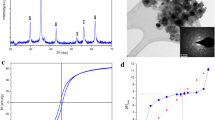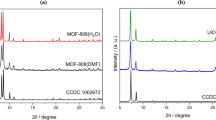Abstract
The adsorption of Cu(II), Mn(II), and U(VI) ions by mesoporous silica nanoparticles (NPs) was investigated by batch experiments to assess the potential using NPs to remediate acid mine drainage (AMD) contaminated water. Adsorption reactions were found to be rapid, attaining equilibrium within 5 min for Cu and less than a minute for Mn and U. Calculated adsorption rates based on the pseudo-second order model (R 2 = 0.99) showed that Mn adsorption was >3 times faster than Cu and 7 times faster than U. Adsorption increased with pH and temperature, and ∆G° and ∆H° values indicate that the process was spontaneous and endothermic. Isotherm data were best described by the Freundlich and Temkin models (R 2 = 0.99), with chemisorption responsible for the removal of Cu and Mn, and adsorption and precipitation for U removal. Importantly, Fe3+, Mn, and SO4 2− ions increased adsorption from 52, 56, and 49 % to 77, 66, and 76 % for Cu, Mn, and U, respectively. Cu removal was, however, inhibited in 1:2 Cu:Mn solutions. NPs were then applied to actual AMD-contaminated ground and surface water. As in simulated AMD, adsorption was higher for Mn than Cu and removal efficiencies of up to 60 % for Mn and 34 % for Cu were attained. These NPs therefore offer an alternative for Mn removal that precludes pH adjustment and the copious amounts of lime required for that. Importantly, they can be used for cost-effective treatment of AMD-contaminated water.
Zusammenfassung
Die Adsorption von Cu(II)-, Mn(II)- und U(VI)-Ionen durch halbporöse Siliziumdioxid-Nanopartikel (NPs) wurde in Batch-Versuchen untersucht, um die potentielle Nutzung der NPs für die Reinigung saurer Grubenwässer zu bewerten. Es wurde festgestellt, dass die Adsorption schnell verläuft und das Gleichgewicht für Cu innerhalb von fünf Minuten und die Gleichgewichte für Mn und U in weniger als einer Minute erreicht wurden. Mit einem pseudo-zweiter Ordnung Modell (R2=0,99) berechnete Adsorptionsraten zeigten, dass Mn mehr als dreimal schneller als Cu und siebenmal schneller als U adsorbiert wurde. Die Adsorption stieg mit dem pH-Wert und der Temperatur an. Die Werte für ∆G° und ∆H° zeigten, dass der Prozess spontan und endotherm verläuft. Die Adsorptionsisothermen konnten am besten mit dem Freundlich- und Temkin-Modell beschrieben werden (R2=0,99). Dabei war Chemisorption für die Entfernung von Cu und Mn verantwortlich und Adsorption und Fällung für die Entfernung von U. Wichtig ist, dass Fe3+-, Mn- und SO 2-4 -Ionen die Adsorption von 52, 56 und 49% auf 77, 66 und 76% erhöhten. Die Cu-Entfernung wurde jedoch in Lösungen mit einem Cu:Mn-Verhältnis 1:2 behindert. Die Nps wurden dann in durch saure Grubenwässer kontaminierten Grund- und Oberflächenwässern angewendet. Wie im künstlichen sauren Grubenwasser war die Adsorption für Mn größer als für Cu. Entfernungsraten von bis zu 60% für Mn und bis zu 34% für Cu wurden erreicht. Damit stellen diese NPs eine Alternative für die Mn-Entfernung dar, die die pH-Anhebung und die dafür nötigen Mengen an Kalk vermeidet. Die NPs können für eine kostengünstige Behandlung saurer Grubenwässer benutzt werden.
Resumen
La adsorción de Cu(II), Mn(II) y U(VI) por nanopartículas mesoporosas de sílica (NPs) se investigó a través de experimentos en batch para determinar el potencial de utilizar NPs para remediar agua contaminada con drenajes ácidos de mina (AMD). Las adsorciones fueron rápidas alcanzando el equilibrio dentro de los 5 minutos para Cu y menos de 1 minuto para Mn y U. Las velocidades de adsorción calculadas utilizando un modelo de pseudo segundo orden (R2 = 0,99) mostraron que la adsorción de Mn fue >3 veces más rápido que Cu y 7 veces más rápido que U. La adsorción se incrementó con el pH y la temperatura y los valores de ∆G° y ∆H° indican que el proceso fue espontáneo y endotérmico. Las isotermas fueron mejor descriptas por los modelos de Freundlich y Temkin (R2 = 0,99), indicando quimiosorción para la remoción de Cu y Mn y adsorción y precipitación para la remoción de U. Es significativo que Fe3+, Mn y SO4 2− incrementaron la adsorción desde 52, 56 y 49 % a 77, 66 y 76 % para Cu, Mn y U, respectivamente. La remoción de Cu fue, sin embargo, inhibida en soluciones 1:2 Cu: Mn. Las NPs fueron aplicadas en aguas superficiales y subterráneas contaminadas con AMD. Como en el AMD artificial, la adsorción fue mayor para Mn que para Cu y se obtuvieron eficiencias de remoción de hasta 60 % para Mn y 34 % para Cu. Estas NPs ofrecen una alternativa para la remoción de Mn que evita el ajuste de pH y las grandes cantidades de lima requeridas para eso. En definitiva, las NPs pueden ser usadas para un tratamiento rentable del agua contaminada con AMD.
抽象
批次试验评价了介孔氧化硅颗粒(NPs)对酸性矿山废水中铜(Cu2+)、锰(Mn2+)和铀(U6+)离子的吸附能力。研究发现吸附反应速度较快,铜达到反应平衡时间为5分钟,比锰和铀达到反应平衡时间短1分钟。基于假二级模型(pseudo-second order model ,R2= 0.99)的计算吸附速率表明,锰吸附速度比铜快3倍,比铀快7倍。吸附率随pH值和温度增大而升高。计算∆G值和∆H值表明吸附反应为自发的吸热反应。弗罗因德利希吸附等温曲线(Freundlich)和Temkin模型(R2= 0.99) 很好地刻画了该吸附反应特征。铜(Cu)和锰(Mn)的去除以化学吸附作用为主;同时,硫酸根离子(SO42-)增多使铜(Cu2+)、锰(Mn2+)和铀(U6+)的吸附去除率分别由52%、56%、77%提高到77%、66%和76%。在Cu: Mn=1:2的溶液的中,铜的去除受到抑制。之后,将介孔氧化硅纳米颗粒应用到实际的地表和井下酸性矿山废水的处理中。与模拟酸性矿山废水结果相似,锰的吸附高于铜,锰的去除率达60%,铜的去除率达34%。介孔氧化硅纳米颗粒为在不改变pH值和消耗大量石灰的前提下去除锰提供了可能。更重要的是,介孔氧化硅纳米颗粒为酸性矿山废水处理提供了一种经济有效方法。








Similar content being viewed by others
References
Akhbarizadeh R, Shayestefar MR, Darezereshki E (2013) Competitive removal of metals from wastewater by maghemite nanoparticles: a comparison between simulated wastewater and AMD. Mine Water Environ 33:89–96. doi:10.1007/s10230-013-0255-3
Babel S, Kurniawan TA (2003) Low-cost adsorbents for heavy metals uptake from contaminated water: a review. J Hazard Mater 97:219–243. doi:10.1016/S0304-3894(02)00263-7
Benjamin MM, Leckie JO (1981) Competitive adsorption of Cd, Cu, Zn, and Pb on amorphous iron oxyhydroxide. J Colloid Interface Sci 83:410–419. doi:10.1016/0021-9797(81)90337-4
Benjamin MM, Leckie J (1982) Effects of complexation by Cl, SO4 and S2O3 on adsorption behaviour of Cd on oxide surfaces. Environ Sci Technol 16:162–170. doi:10.1021/es00097a008
Brown GE, Henrich VE, Casey WH, Clark DL, Eggleston C, Felmy A, Goodman DW, Grätzel M, Maciel G, McCarthy MI, Nealson KH, Sverjensky DA, Toney MF, Zachara JM (1999) Metal oxide surfaces and their interactions with aqueous solutions and microbial organisms. Chem Rev 99:77–174. doi:10.1021/cr980011z
Durand JF (2012) The impact of gold mining on the Witwatersrand on the rivers and karst system of Gauteng and North West Province, South Africa. J Afr Earth Sci 68:24–43. doi:10.1016/j.jafrearsci.2012.03.013
Engates KE, Shipley HJ (2011) Adsorption of Pb, Cd, Cu, Zn, and Ni to titanium dioxide nanoparticles: effect of particle size, solid concentration, and exhaustion. Environ Sci Pollut Res Int 18:386–395. doi:10.1007/s11356-010-0382-3
Foo KY, Hameed BH (2010) Insights into the modeling of adsorption isotherm systems. Chem Eng J 156:2–10. doi:10.1016/j.cej.2009.09.013
Georgopoulos PG, Roy A, Opiekun RE, Lioy PJ (2011) Environmental copper: its dynamics and human exposure issues. J Toxicol Environ Heal B 4:341–394. doi:10.1080/109374001753146207
Guzmán KAD, Taylor MR, Banfield JF (2006) Environmental risks of nanotechnology: national nanotechnology initiative funding, 2000–2004. Environ Sci Technol 40:1401–1407. doi:10.1021/es0515708
Ho YS, Mckay G (2004) Sorption of copper(II) from aqueous solution by peat. Water Air Soil Pollut 158:77–97. doi:10.1023/B:WATE.0000044830.63767.a3
Hua M, Zhang S, Pan B, Zhang W, Lv L, Zhang Q (2012) Heavy metal removal from water/wastewater by nanosized metal oxides: a review. J Hazard Mater 212:317–331. doi:10.1016/j.jhazmat.2011.10.016
James RO, Healy TW (1972a) Adsorption of hydrolyzable metal ions at the oxide-water interface. I. Co(II) adsorption on SiO2 and TiO2 as model systems. J Colloid Interface Sci 40:42–52. doi:10.1016/0021-9797(72)90174-5
James RO, Healy TW (1972b) Adsorption of hydrolyzable metal ions at the oxide-water interface. III. A thermodynamic model of adsorption. J Colloid Interface Sci 40:65–81. doi:10.1016/0021-9797(72)90174-9
Johnson DB, Hallberg KB (2005) Acid mine drainage remediation options: a review. Sci Total Environ 338:3–14. doi:10.1016/j.scitotenv.2004.09.002
Kolver L (2014) Central Rand Gold Mill 3 operational, AMD treatment started. In: Eyewitness news http://ewn.co.za/BusinessData/CRG%20Mill%203%20operational_%20AMD%20treatment%20started%20_%20Leandi%20Kolver. Accessed 17 July 2014
Kosmulski M (1999) Adsorption of trivalent cations on silica. J Colloid Interface Sci 211:410–412. doi:10.1006/jcis.1998.6034
Kosmulski M (2000) Sorption of heavy metal cations on silica. In: Papirer E (ed) Adsorption on silica surfaces. Marcel Dekker, New York, pp 399–437
Kosmulski M (2009) pH-dependent surface charging and points of zero charge. IV. Update and new approach. J Colloid Interface Sci 337:439–448. doi:10.1016/j.jcis.2009.04.072
Krestou A, Xenidis A, Panias D (2003) Mechanism of aqueous uranium (VI) uptake by natural zeolitic tuff. Miner Eng 16:1363–1370. doi:10.1016/j.mineng.2003.08.012
KTH Royal Institute of Technology (2004) HYDRA/MEDUSA
Lee H, Yi J (2007) Removal of copper ions using functionalised mesoporous silica in aqueous solution. Sep Sci Technol 36:2433–2448. doi:10.1081/SS-100106101
Lee HW, Cho HJ, Yim JH, Kim JM, Jeon JK, Sohn JM, Yoo KS, Kim SS, Park YK (2011) Removal of Cu(II)-ion over amine-functionalized mesoporous silica materials. J Ind Eng Chem 17:504–509. doi:10.1016/j.jiec.2010.09.022
LeVan MD, Vermeulen T (1981) Binary langmuir and freundlich isotherms for ideal adsorbed solutions. J Phys Chem 85:3247–3250. doi:10.1021/j150622a009
Madden A, Hochella M (2005) A test of geochemical reactivity as a function of mineral size: manganese oxidation promoted by hematite nanoparticles. Geochim Cosmochim Acta 69:389–398. doi:10.1016/j.gca.2004.06.035
Meridian Institute (2006) Overview and comparison of conventional treatment technologies: nano-based treatment technologies. In: Proceedings of the international workshop on nanotechnology, water, and development, pp 7–38. http://www.merid.org/~/media/Files/Projects/nano-waterworkshop/watertechpaper.ashx
Michard P, Guibal E, Vincent T, Le Cloirec P (1996) Sorption and desorption of uranyl ions by silica gel: pH, particle size and porosity effects. Microporous Mater 5:309–324. doi:10.1016/0927-6513(95)00067-4
Naicker K, Cukrowska E, McCarthy TS (2003) Acid mine drainage arising from gold mining activity in Johannesburg, South Africa and environs. Environ Pollut 122:29–40. doi:10.1016/S0269-7491(02)00281-6
Nightingale ER (1959) Phenomenological theory of ion solvation. Effective radii of hydrated ions. J Phys Chem 63:1381–1387. doi:10.1021/j150579a011
Nilchi A, Dehaghan T, Garmarodi S (2013) Kinetics, isotherm and thermodynamics for uranium and thorium ions adsorption from aqueous solutions by crystalline tin oxide nanoparticles. Desalination 321:67–71. doi:10.1016/j.desal.2012.06.022
Nriagu JO (1988) A silent epidemic of environmental metal poisoning? Environ Pollut 50:139–161. doi:10.1016/0269-7491(88)90189-3
Ramadan H, Ghanem A, El-rassy H (2010) Mercury removal from aqueous solutions using silica, polyacrylamide and hybrid silica—polyacrylamide aerogels. Chem Eng J 159:107–115. doi:10.1016/j.cej.2010.02.051
Saad DM, Cukrowska EM, Tutu H (2013) Selective removal of mercury from aqueous solutions using thiolated cross-linked polyethylenimine. Appl Water Sci 3:527–534. doi:10.1007/s13201-013-0100-7
Sing KSW, Everett DH, Haul RA, Moscou L, Pierotti RA, Rouquerol J, Siemieniewska T (1985) Reporting physisorption data for gas/solid systems. Pure Appl Chem 57:603–619. doi:10.1002/9783527610044.hetcat0065
Štamberg K, Venkatesan KA, Vasudeva Rao PR (2003) Surface complexation modeling of uranyl ion sorption on mesoporous silica. Colloid Surf A 221:149–162. doi:10.1016/S0927-7757(03)00139-0
Swann GEA, Patwardhan SV (2011) Application of Fourier transform infrared spectroscopy (FTIR) for palaeoenvironmental research. Clim Past 65–74. doi:10.5194/cp-7-65-2011
Tutu H, McCarthy TS, Cukrowska E (2008) The chemical characteristics of acid mine drainage with particular reference to sources, distribution and remediation: the Witwatersrand Basin, South Africa as a case study. Appl Geochem 23:3666–3684. doi:10.1016/j.apgeochem.2008.09.002
Weber JW, Morris JC (1963) Kinetics of adsorption on carbon from solutions. J Sanit Eng ASCE 89(2):31–60
Wu S, Li F, Xu R, Wei S, Li G (2009) Synthesis of thiol-functionalized MCM-41 mesoporous silicas and its application in Cu(II), Pb(II), Ag(I), and Cr(III) removal. J Nanoparticle Res 12:2111–2124. doi:10.1007/s11051-009-9770-3
Yavuz O, Altunkaynak Y, Güzel F (2003) Removal of copper, nickel, cobalt and manganese from aqueous solution by kaolinite. Water Res 37:948–952. doi:10.1016/S0043-1354(02)00409-8
Acknowledgments
Funding for this work was provided by the Global Change and Sustainability Research Institute (GCSRI) of the University of Witwatersrand in the form of a Ph.D. fellowship to A.E. We acknowledge the contributions of Kirstin Olsen with field sampling, Siyethemba Mabaso with ICP-OES analyses, and Jacques Gerber of the Microscopy and Microanalysis Unit.
Author information
Authors and Affiliations
Corresponding author
Electronic supplementary material
Below is the link to the electronic supplementary material.
Rights and permissions
About this article
Cite this article
Etale, A., Tutu, H. & Drake, D.C. Mesoporous Silica Nanoparticles for the Adsorptive Removal of Cu(II), Mn(II), and U(VI) from Acid Mine Drainage. Mine Water Environ 34, 231–240 (2015). https://doi.org/10.1007/s10230-014-0311-7
Received:
Accepted:
Published:
Issue Date:
DOI: https://doi.org/10.1007/s10230-014-0311-7




